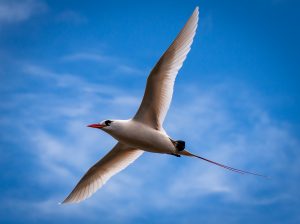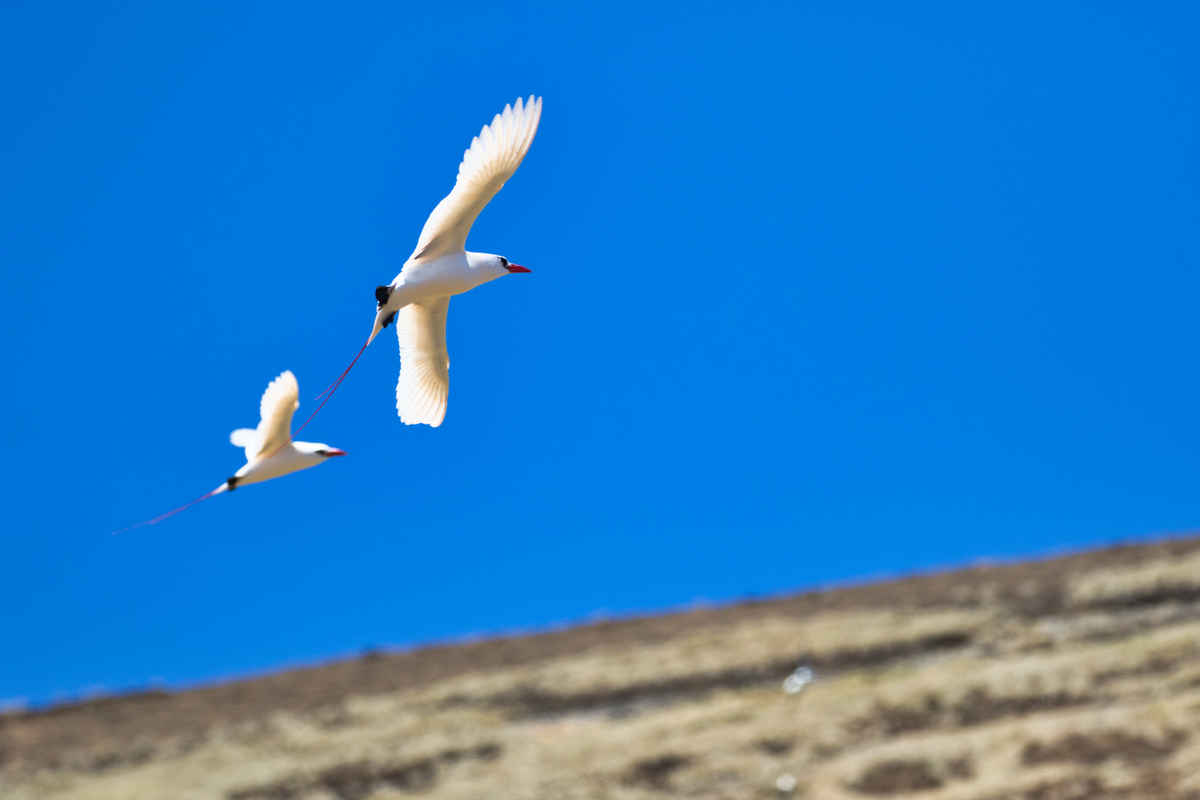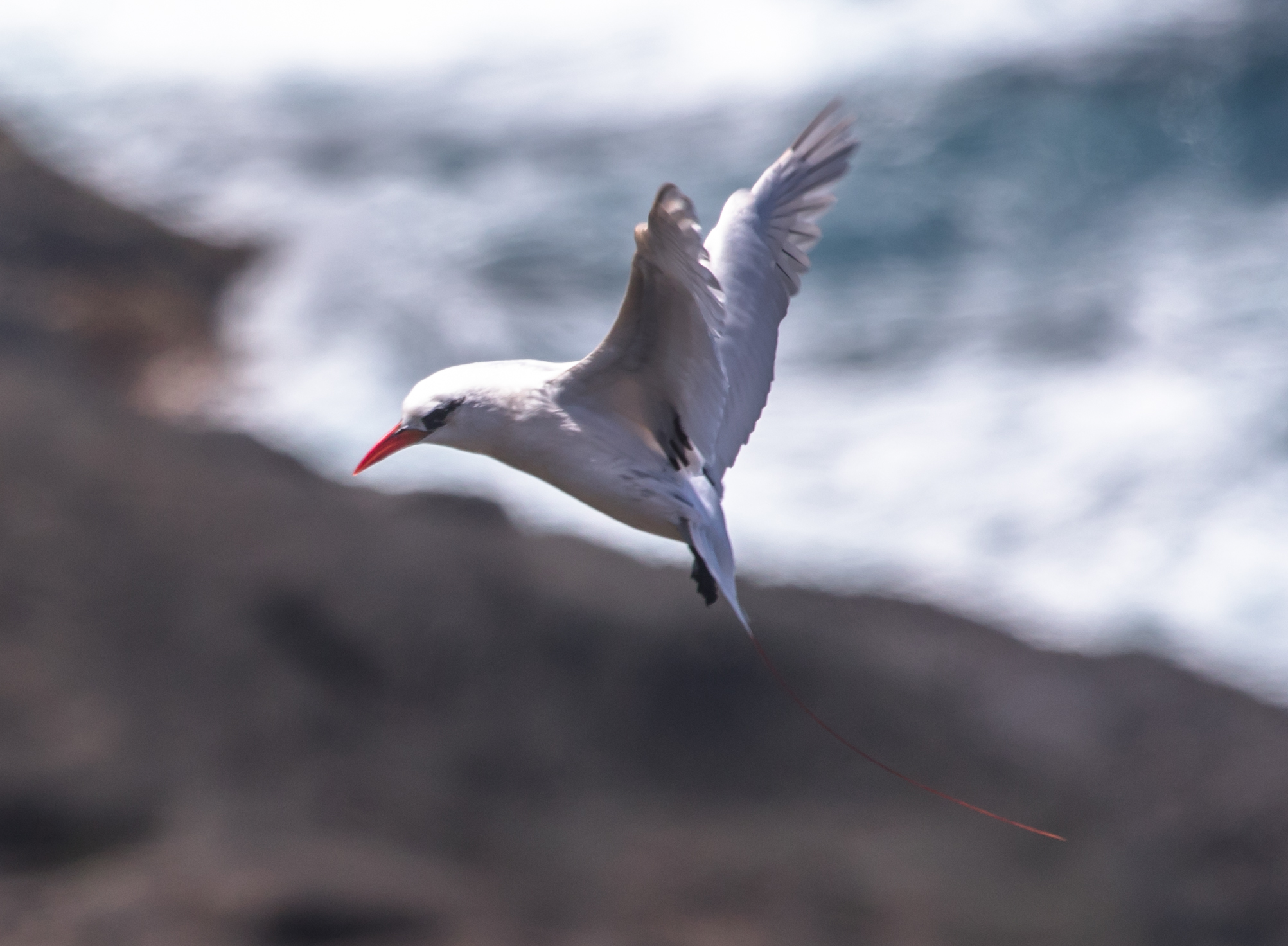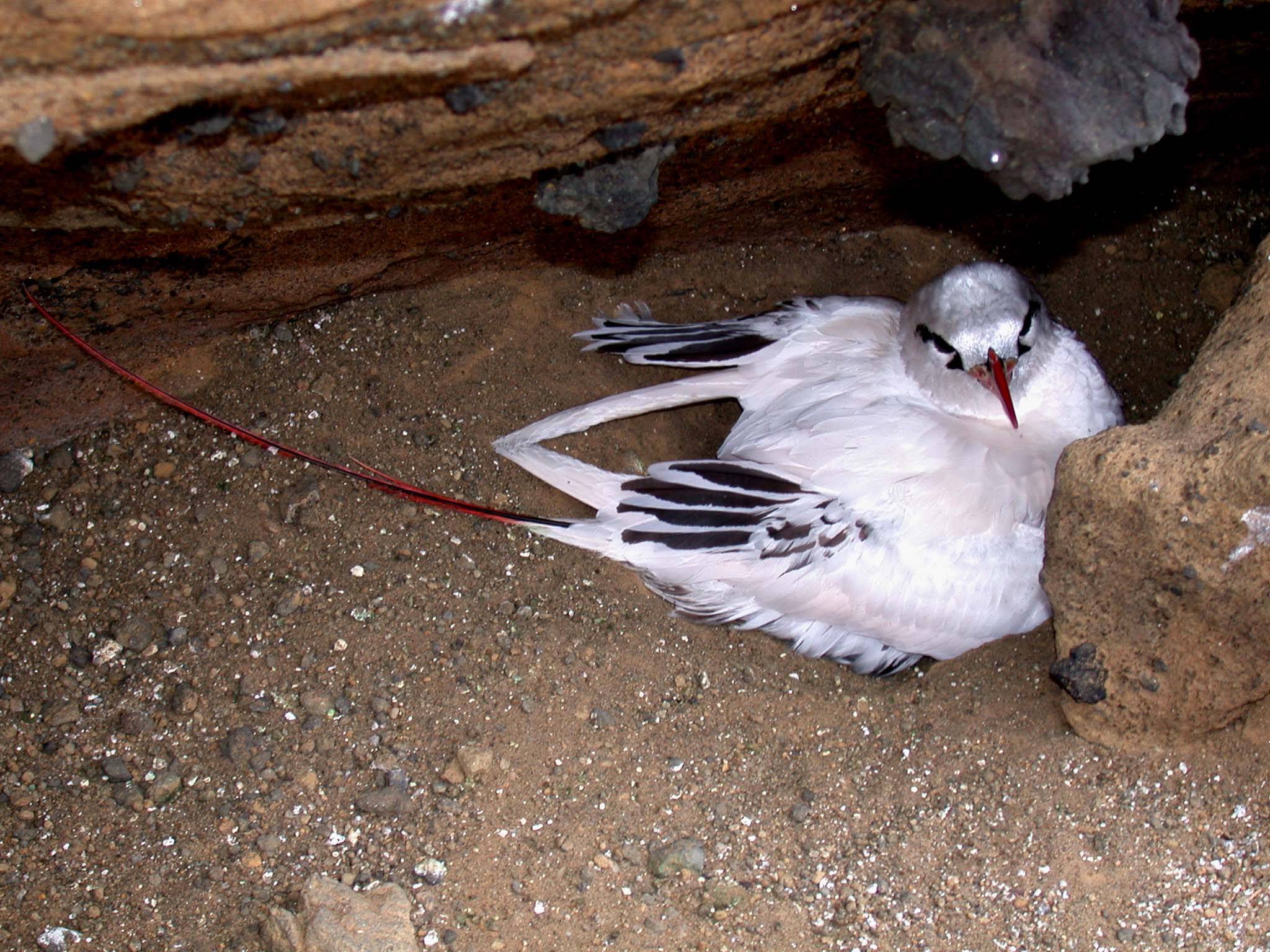Koaʻeʻula

Names
- ʻŌlelo Hawaiʻi: Koa‘e ‘ula
- Common: Red-tailed Tropicbird
- Scientific: Phaethon rubricauda
Song
Conservation Status
- IUCN Red List Ranking: Least Concern
Species Information

Koaʻeʻula or Red-tailed Tropicbird. PC: Lainie Berry
The koa‘e ‘ula or red-tailed tropicbird is a showy, white seabird (Family: Phaethontidae) related to boobies and frigatebirds. Four koa‘e ‘ula (red-tailed tropicbird) subspecies are recognized, and one (P. r. roseotincta) breeds in Hawai‘i. Adult males and females are mostly white, although sometimes with pale pinkish wash, except for partial black eye ring and short eye line, black flanks, and black shafts of outer primaries. Both sexes have long, narrow, tail feathers with red shafts. Large reddish orange bill with black tip; legs and feet are very small. Flight is characterized by strong flapping interspersed with gliding; koa‘e ‘ula (red-tailed tropicbird) are capable of flying long distances. Koa‘e ‘ula (red-tailed tropicbird) usually forage alone, but occasional with other species, most often far from land; often will follow ships. Koa‘e ‘ula (red-tailed tropicbird) captures prey by plunge diving. In Hawai‘i, diet is mainly comprised of flyingfish, but also takes squid, mackerel scads, dolphinfish, truncated sunfish, and ballonfish. Koa‘e ‘ula (red-tailed tropicbird) breed in colonies and pairs remain together for years. At the beginning of the breeding season, pairs engage in complex aerial displays. Nests are placed on the ground, and generally are a simple scrape lined with some vegetation. In Hawai‘i, breeding can occur throughout the year, but most nests are active between February and June. A single egg is laid per season, and both parents incubate the egg, and brood and feed the chick. No post-fledgling (after-flight) care is provided. Age at first breeding is between two and four years, and the oldest known individual was 23 years old.
Distribution
Koa‘e ‘ula (red-tailed tropicbird) breed throughout the NWHI and at a limited number of sites on MHI, mostly on offshore islets, but possibly on Ni‘ihau, Ka‘ula, Lāna‘i, and Kaho‘olawe. Outside of Hawai‘i, koa‘e ‘ula (red-tailed tropicbird) breed on oceanic islands in the Indian and Pacific oceans. Outside the breeding season, adults are solitary and pelagic, and their range is poorly known.
Habitat
Terrestrial: Koa‘e ‘ula (red-tailed tropicbird) breed mainly on oceanic islands and coral atolls with shrubs, including beach magnolia (Scaevola sericea) and beach heliotrope (Tournefortia argentea). Koa‘e ‘ula (red-tailed tropicbird) nest on the ground, generally in inconspicuous places such as under vegetation or in cliff crevices. Marine: Pelagic.
Threats
- Introduced predators. Like all seabirds, adults and nests susceptible to predation by rats (Rattus spp.) and feral cats (Felis silvestris). All sites in NWHI are free of rats and cats.
Learn more
Plans & Projects
- Kauaʻi Endangered Seabird Recovery Project (KESRP)
- Maui Nui Seabird Recovery Project (MNSRP)
- Lehua Island Ecosystem Restoration Project
Photos
Additional Resources
For more information and references visit the DLNR State Wildlife Action Plan factsheets. DOFAWʻs species pages and State Wildlife Action Plan fact sheets are provided for general information and are not meant to be a citable, original source of data. If you are a student, researcher, or writer looking for a citable source, please explore the references below or find other original data sources, rather than citing these webpages. The references below were provided by the authors of the State Wildlife Action Plan fact sheets at the time of drafting:
- Kushlan JA, et al. 2002. Waterbird Conservation for the Americas: The North American waterbird conservation plan, Version 1 Waterbird Conservation for the Americas, Washington, DC. 78pp. Available at: www.waterbirdconservation.org.
- NatureServe. 2003. Downloadable animal data sets. NatureServe Central Databases. Available at: https://www.natureserve.org/getData/vertinvertdata.jsp (March 10, 2005).
- Schreiber EA, Schreiber RW. 1993. Red-tailed tropicbird (Phaeton rubricauda). In The Birds of North America, No. 43 (Poole A, Gill F, editors.). Philadelphia, (PA): The Academy of Natural Sciences; and Washington DC: The American Ornithologists’ Union.
- U.S. Fish and Wildlife Service. 2005. Regional seabird conservation plan, Pacific Region. U.S. Fish and Wildlife Service, Migratory Birds and Habitat Programs, Pacific Region. Portland, (OR): U.S. Fish and Wildlife Service.

 Lehua Island: Restoration of a Tropical Bird Paradise
Lehua Island: Restoration of a Tropical Bird Paradise Lehua Island: Past & Future Story Map
Lehua Island: Past & Future Story Map


